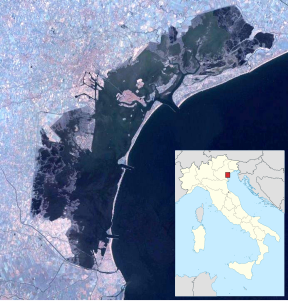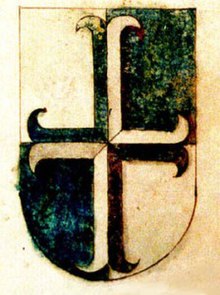San Giorgio in Alga
| San Giorgio in Alga | ||
|---|---|---|
| Waters | Venice lagoon | |
| Geographical location | 45 ° 25 '29.3 " N , 12 ° 17' 30.8" E | |
|
|
||
| surface | 1.511 3 ha | |
| Residents | uninhabited | |
San Giorgio in Alga (in the sea grass) is an approximately rectangular island in the Venice lagoon . It lies between the Giudecca and Fusina and has an area of 15,113 m². On it are the remains of a monastery that existed from around 1000 to 1806 and that served as a fortress and quarry from 1810 to the Second World War .
history
There have been various monasteries on the island over the centuries. The first, a Benedictine monastery , was built around the year 1000. In the middle of the 14th century a Spanish hermit lived here who lived according to the rules of the Augustinians . He and his students founded the Congregation of Lorenzo in Alga di Venezia . In 1379 she was united with the hermits going back to Pietro da Pisa.
In 1404 the Canon Regulars of San Giorgio in Alga were founded here, a community from which the later Popes Eugene IV and Gregory XII. , as well as her cousin and cardinal nephew Antonio Correr and Ludovico Barbo , her first headmaster and later abbot of the Basilica Santa Giustina in Padua , and Saint Lorenzo Giustiniani (1383-1456) emerged - the latter was her second headmaster. In 1433 he became Bishop of Castello and in 1451 Patriarch of Venice when Castello and the Patriarchate of Grado were merged. Until then, the center of reform in Italy was the Santa Giustina Abbey. Cardinal Angelo Barbarigo ordered the conversion into a reformed, secular collegiate foundation on October 30, 1404. Its second head was 1424 Lorenzo Giustiniani, brother of the humanist Leonardo Giustiniani . The monastery had 17 members, not only Venetian nobles such as Stefano and Dominco Morosini, Marco Condulmer and Francesco Barbo, priests, deacons and sub-deacons, but also men from Milan , Verona , Pavia and Cremona . They had previously lived on the Lido in a Benedictine monastery dedicated to St. Nicholas. The community worked throughout southern Europe as far as Spain and was abolished in 1668.
After a fire in July 1716 destroyed large parts of the monastery, the rest of the building fell into disrepair after the earthquake of July 14, 1779.
In 1799 a prison for political prisoners was established here. In 1806 the church was destroyed and a powder magazine was installed in the prison.
On July 29, 1848, the Austrians launched an attack from Fusina against the rebellious Venetians , more precisely against San Giorgio in Alga, which had been heavily fortified the previous year. However, the attack ended with the defeat of the two ships and the three fires.
From June to November 1944 there was a secret school for German combat swimmers on the island , the training camp 701 .
Vittorio Cini , the founder of the Fondazione Giorgio Cini , toyed with the idea of setting up a cultural foundation there in the 1950s, but during a visit he discovered that the dilapidated buildings could no longer be saved.
The island has been uninhabited since the Second World War , when three anti-aircraft guns were stationed there, and today belongs to the municipality of Venice . The patriarch bought the island in 1961 for 1.8 million lire , but in 1973 he donated it to the city.
Web links
- Islands of Venice. San Giorgio in Alga ( Memento of May 11, 2011 in the Internet Archive ), archive.org, May 11, 2011
- Augustinian canons
Remarks
- ↑ Giuseppe Cappeletti: Storia della Repubblica di Venezia , 13 vols, Venice. Antonelli 1850-1855, Vol 6, Venice 1850 S. 404th.
- ^ Giorgio Cracco: La fondazione dei canonici secolari di San Giorgio in Alge , in: Rivista di Soria della Chiesa in Italia 13 (1959) 84-86.
- ^ Uginet, François-Charles: "Antonio Corner" in: Dizionario Biografico degli Italiani, Volume 29 (1983) online
- ^ Marie-Luise Favreau-Lily: Devotio moderna in Italy? Contacts between 'Prague' and Venice in the 14./15. Century and the search for new ways of piety in Veneto , in: Marek Derwich, Martial Staub (Ed.): The "New Piety" in Europe in the late Middle Ages, Göttingen 2004, pp. 301-330. (on-line)
- ^ Venice: Historical-topographical-artistic travel guide for visitors to the lagoon city , Trieste: Literar. artist. Department of Austria. Lloyd 1854, p. 165.
- ↑ Actually a sequence of five earthquakes that occurred on June 4th and 10th, on July 14th and November 23rd, 1779 and on February 6th, 1780 (Enzo Boschi, Emanuela Guidoboni: I terremoti a Bologna e nel suo territorio dal XII al XX secolo , Istituto nazionale di geofisica e vulcanologia, 2003, p. 101).
- ^ For example, Ludwig von Simonyi writes: The Lombard-Venetian Kingdom. Characteristic, artistically, topographically, statistically and historically presented and rewritten into a complete travel guide for all cities of the kingdom , Vol. 1, Milan 1844, p. 486.
- ^ Johann Debrunner: Venezia nel 1848-49 , Turin 1851, p. 114.
- ↑ Joachim Beckh: Lightning and Anchor , Volume 2: Information Technology, History & Backgrounds, p. 523.
- ^ Paolo Vian: Don Giuseppe De Luca. a cento anni della nascità , Rome 1998, p. 48.


